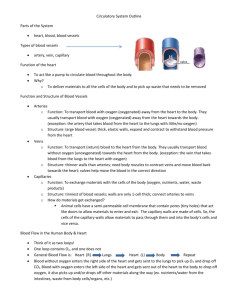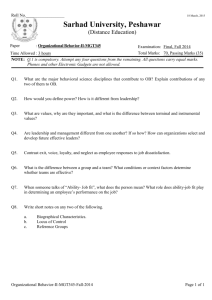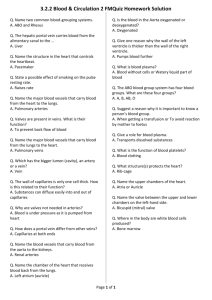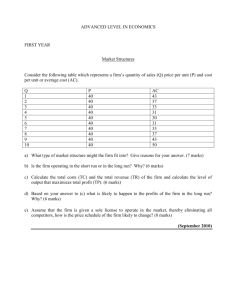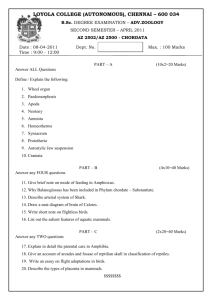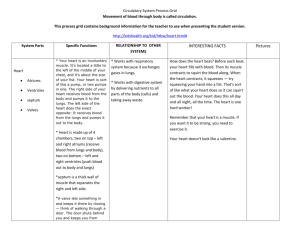End of unit 7 test - Circulatory system
advertisement
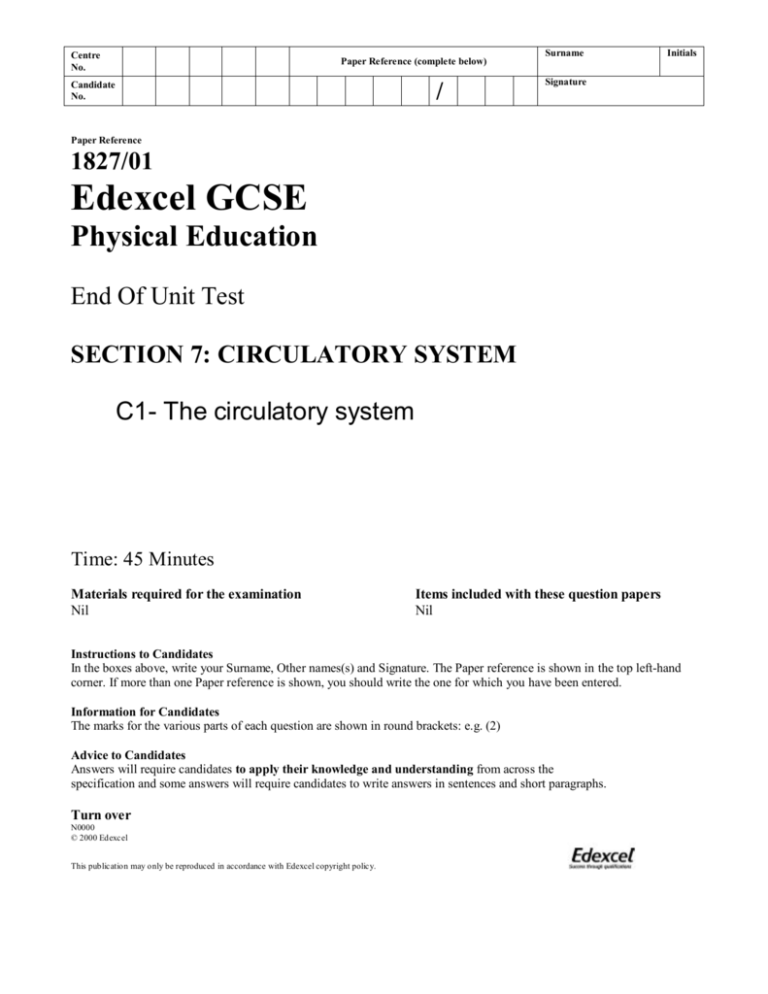
Centre No. Paper Reference (complete below) Candidate No. / Surname Initials Signature Paper Reference 1827/01 Edexcel GCSE Physical Education End Of Unit Test SECTION 7: CIRCULATORY SYSTEM C1- The circulatory system Time: 45 Minutes Materials required for the examination Nil Items included with these question papers Nil Instructions to Candidates In the boxes above, write your Surname, Other names(s) and Signature. The Paper reference is shown in the top left-hand corner. If more than one Paper reference is shown, you should write the one for which you have been entered. Information for Candidates The marks for the various parts of each question are shown in round brackets: e.g. (2) Advice to Candidates Answers will require candidates to apply their knowledge and understanding from across the specification and some answers will require candidates to write answers in sentences and short paragraphs. Turn over N0000 © 2000 Edexcel This publication may only be reproduced in accordance with Edexcel copyright policy. 1. A shortage of red blood cells will reduce A. B. C. D. Antibody formation Glucose uptake Oxygen Transport Clotting (1 mark) 2. The pulmonary Artery transports: A. B. C. D. De-oxygenated blood to the heart De-oxygenated blood to the lungs Oxygenated blood to the heart Oxygenated blood to the lungs (1 mark) 3. The cardiovascular system consists of: A. B. C. D. The heart, blood, and the lungs The heart, blood vessels and the lungs The heart, Blood and the blood vessels The blood, blood vessels and the lungs. (1 mark) 4. Platelets are responsible for A. B. C. D. Clotting Fighting infection Carrying Oxygen Carrying Carbon Dioxide (1 mark) 5. In the circulatory system, valves are found A. B. C. D. in all arteries and veins only in the heart in veins and the heart only in the veins. (1 mark) 2 6. The heart has three different types of valves. i. Name the three valves, (3 marks) ii. What is the common purpose of these valves in the heart? (1 marks) 7. How does the body use blood to stop the body overheating during exercise? (2 marks) 8. For each of the following component of blood, state whether the components main function is transport or protection i. white cells ii. red cells iii. plasma iv. platelets (4 marks) 9. Fill in the blanks using the word arteries or veins. i. ………………………………. Work under high pressure ii. ………………………………. Rarely pulsate iii. ……………………………….have thick walls iv. ……………………………….have elastic walls. (4 marks) 10. Define the following terms i. Stroke volume (2 marks) ii. heart rate (2 marks) 11. Explain the immediate effect of exercise on i. Stroke volume ii. Heart rate (2 marks) 3 12. Figure 1. is a diagram of the human heart. A D C B a) Complete the following table by naming the parts labelled A, B ,C and D and describe the function of each. Label Anatomical Name Function A B C D (8 marks) b) What effect would training have on the part labelled B? (1 mark) c) What type of muscle is B made from? (1 mark) d) Which chamber A or D would contain oxygenated blood? (1 mark) e) What blood vessel carries blood away form the heart to the body. (1 mark) f) State two ways that arteries are different to Veins. (2 marks) 13. The Cardiovascular system is made up of two circuits, the systemic is one, what is the name of the other. (1 marks) 4 14. Complete the following sentences by filling in the gaps. Arteries and veins are two of the three main types of blood vessel. The third type of blood vessel which are much smaller are called……………………… These blood vessels have thin walls which are one ………………. Thick. These walls are very thin because………………………………………………………………………………………………… The pulmonary artery is the main blood vessel that carries blood to the lungs, the name of the main blood vessel that return blood from the lungs to the heart is the ………………………….. The main artery that takes blood away from the heart is called the ………………………. The amount of force that the blood applies to the walls of the blood vessel is called blood………………… (6 mark) 15. Ashan is a 16 years old. He is studying GCSE PE and decided to measure his heart rate during training to help him monitor his fitness. Figure 2 shows a record of Ashan’s heart rate before, during and after a training session. 210 190 170 150 130 110 90 70 50 30 Start of training Finish of training a) What happens to Ashan’s heart rate at the start of training? (1 mark) b) What will happen to his cardiac output? (1 mark) c) Explain why it is important to Ashan that his heart alters in this way. (1 mark) d) state one ways that Ashan’s cardiovascular system will improve as a result of regular training? (1 mark) TOTAL 50 MARKS 5 ANSWERS 1. 2. 3. 4. 5. C B C A C 6. a. b. 7. moves hot blood to extremities moves cold blood to core. (vasodilatation) 8. i. ii. iii. iv. Potection Transport Transport Protection 9. i. ii. iii. iv. arteries Veins Arteries Arteries 10. i. the amount of blood ejected from the right ventical in one heart beat ii. the number of times the heart beats in one minute 11. i. ii. increase increase 12. A B C. D. right atrium received blood from body heart wall Keeps blood in Septum Separate oxygenated and deoxygenated blood Left ventricle Pumps blood to lungs b. increase in size c. Cardiac d, D e. Aorta f, thicker walls, no valves, thinner lumen, elastic. 13. Pulmonary 14. capillaries cell they must allow O2 to pass through pulmonary vein pressure. a. increases b. increase c. to get blood to muscles d. decrease resting HR, size of heart, atrophy of heart, more blood vessels. 15. Biscupid (mitral), tricuspid semilunar to stop the back flow of blood 6
